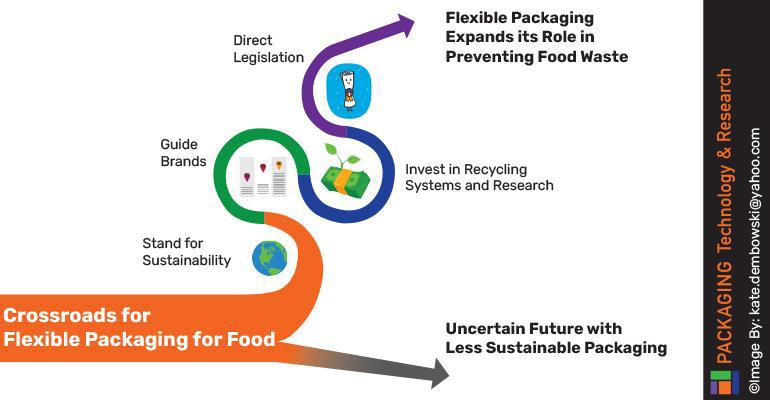The straight and narrow road leads flexibles to an uncertain future and less sustainable packaging. The longer route expands the role of flexibles in preventing food waste.
The flexible packaging industry is once again at a critical crossroads. Insights gained from talking shop at ReFED and the Global Pouch Forum defined for me the critical nature of this crossroad.
One road — the straight and narrow road — leads to an uncertain future and less sustainable packaging. The other road — tough and complex — expands the role of flexible packaging in preventing food waste.https://3d8739aea79e63d6a7bb9b27fdbd45cd.safeframe.googlesyndication.com/safeframe/1-0-38/html/container.html
Taking these four “turns” can make this crucial road trip more manageable:
Turn 1: Stand for sustainability.
Measure how flexible packaging prevents food waste.
- The immense environmental impact of food waste is best weighed alongside the impact that packaging has on the environment when it prevents food waste. This is true for all packaging.
- Flexible packaging solutions that prevent food waste are numerous and within every food category — skin package chubs of ground meat, cereal bag liners, shrink-wrapped produce, MAP and barrier snack food bags, bag-in-box beverages, and lidding on tofu, and dairy products.
- Flexible packaging often represents a reduction (the first R in the 3Rs) in packaging material used, and this is best determined with life cycle assessment (LCA) tools such as Piqet.
Turn 2: Guide brands.
Define “guardrails” for brands in achieving a more sustainable food system that links food waste prevention and more sustainable packaging
- The food industry’s significant environmental impact can be lowered; and aligning with commitments to achieve a more sustainable food system is critical.
- Brands are adopting packaging solutions to reduce food waste across categories vs. solely category-specific solutions. This allows consumers to gain familiarity with technology and packaging elements beyond similar graphics to serve as the connector for consumers. In addition, defining how these options are viable with flexible packaging eases the brand transition.
- Demonstrating the impact of flexible packaging choices on preventing food waste will assist the flexible packaging industry

Turn 3: Invest in recycling systems and research.
Create and share a knowledge base of how to achieve success for speedy tech-transfer of solutions
- An industry knowledge base depository is crucial for problem-solving in converting multilayer structures into alternate structures such as recycle-ready polyethylene (PE). A few closely held solutions are stagnating implementation. A problem-solving depository would reduce the conversion time and increase understanding of implications.
Store drop-off of recyclable flexible packaging is now possible at retailers like Wal-Mart, Target, and other retailers. Also, industry knowledge on the impact of conversion to PE store-drop-off brings the value of packaging centerstage that’s ready for sharing in terms of…
- Product reformulations — to compensate for a lower barrier package, the addition of preservatives is used to maintain shelf life
- Logistics — to allow for shorter shelf life, production run frequency, shorter production runs, and distribution dynamics are reassessed
- Finance — to address higher material costs associated with the use of more PE due to a required thicker film
- LCA — to determine the environmental implications of using more PE versus other materials
- Research investments aligned with flexible packaging to prevent even more food waste require concerted funding. For example, the ability to print batteries onto flexible packaging promises to lower the cost of intelligent packaging to assist in communicating how much time remains to consume the product to retailers and consumers.
Turn 4: Direct legislation.
Legislate flexible packaging into our existing and emerging post-consumer handling systems.
- The flexible packaging industry must stretch into the existing collection, sorting, and recycling systems. Since flexible film is not currently part of the current system, shifts are being made away from source-reduced flexible packaging. While this switch can allow food shelf life to be maintained, it will require more packaging consumption, which will increase the environmental impact of the food chain due to the changes.
- Regional recycling and using post-consumer recycled (PCR)-content packaging lowers the cost and environmental impact of flexibles. The MBold-Charter Next Generation-MyPlas collaboration represents a critical push and pull needed to secure films for recycling and use the recyclate from the film on a regional basis. This collaboration includes a $9.2 million joint equity investment by General Mills, Schwan’s, Target, Ecolab, and film manufacturer Charter Next Generation in film recycler Myplas USA. Slated to be completed in Spring 2023, the Myplas USA 170,000 square foot recycling facility will be able to recycle 90 million pounds of low- and high-density polyethylene packaging and film.
Wisconsin-based Charter Next has an off-take agreement to purchase the bulk of Myplas’ resin in the initial years of operation. Similarly, focused efforts for recycling flexible packaging in urban centers are warranted.
- The flexible packaging industry must focus on eradicating chemicals of concern such as phthalates, per- and polyfluoroalkyl substances (PFAS), and perchlorate so that recycling and reuse are viable.
Leaning into these four “turns” and others on the road trip is essential to avoid crippling flexible packaging and inhibiting its ability to prevent food waste.
I hope to see you on the road.
Claire Sand has 30+ years of experience in industry and academia. She’s owner of Packaging Technology and Research and Gazelle Mobile Packaging and an Adjunct Professor, CalPoly, Michigan State University, and the University of Minnesota. You can reach her at www.packagingtechnologyandresearch.com or via email claire@packagingtechnologyandresearch.com.
Source:https:







